While social media and messengers are taking the digital communication by storm, email marketing is still a top way to generate and nurture leads. However, email campaigns do fail to succeed sometimes. In 40% of cases, this happens due to a weak e-marketing strategy.
In this article, we’ll unscramble the main steps towards a successful email marketing strategy that will help you grow your business and improve your revenue.
Why you need an email marketing strategy plan
An effective e-marketing strategy helps you to
- direct your business. Although getting ready with an e-marketing strategy is a time-consuming process, it is always useful for defining what marketing to send and which audience to target.
- choose the tactics to apply. Define your dream customers, choose how to address them, and think which offers may appeal to them. This way you’ll be able to decide how to run your email marketing campaign.
- collect the data about your audience. Find out information about their age, gender, lifecycle stage, and their buying behavior to build up customer profiles.
- determine the target audience. Figure out the interests of your audience, the reason why they subscribed to your content so that you can tailor the content you will send to their preferences.
- identify the performance of your email campaigns. Are you sending out campaigns to escalate the number of opens and clicks or improve the revenue? No matter what goal your email has, make sure you’ve set the right KPI to track the effectiveness of your email campaign.
How to create an email marketing strategy
So, how to develop an effective email marketing strategy? Here’s a step by step guide from SendPulse.
1. Define your email marketing goals
Before you start your email marketing campaign, you should understand why you’re sending it. In other words, figure out the goals of your campaign to see whom and what to send.
Whatever email campaign you are going to launch, make sure your goal is
Clear
Be as precise as possible while setting the goal for your campaign. Determine for whom you’re doing it, what you want the audience to do, what benefits it will bring to both of you after the intended action is taken.
Let’s say you’re going to create an abandoned cart email. Your goal here will be to bring the user back to the cart and receive 20% from additional sales.
Achievable
Account on your budget, your resources, time, and skills.
E.g. You will account on $100 a month from your budget for this campaign.
Time-bound
Set the due date when you should complete your goal.
E.g. You’ll have two months to set the process up and check its efficiency.
Measurable
Make sure you specify metrics that will help you achieve your goal and track the success of your campaign: the number of opens and click-throughs, forwards, spam complaints, or conversion rate.
E.g. The open rate of this campaign should comprise no less than 30%; otherwise you’ll need to analyze the results, revise the campaign, and come up with its makeover.
2. Build a quality mailing list
Before sending an email campaign, you need to gather the list of contacts whom you will email. There are several ways you can collect email addresses for your database.
Some marketers go the easiest way and buy an email list. However, such an approach is no good for a high sender reputation — with a purchased contact list a sender gets recipients who never agreed to receive their emails, so the chances to hit the spam folders escalate.
However, by adding subscription forms to your website, you’ll be able to collect a quality list of subscribers who are eager to hear from you. Place it in high-traffic areas — a sidebar, at the end of a blog post, in the footer of your website — or integrate the signup form with your Facebook page.
DrMartens, for example, placed the subscription form at the footer of their website, asking the users to specify the products they are interested in.
 A subscription form on Dr.Martens
A subscription form on Dr.Martens
In SendPulse, you may find four types of subscription forms: embedded, popup, floating, and fixed. What is more, you can use the drag and drop editor to construct the form with preferable elements and variables. Add a signup drop-down form so that the users could subscribe to the appealing kind of content:
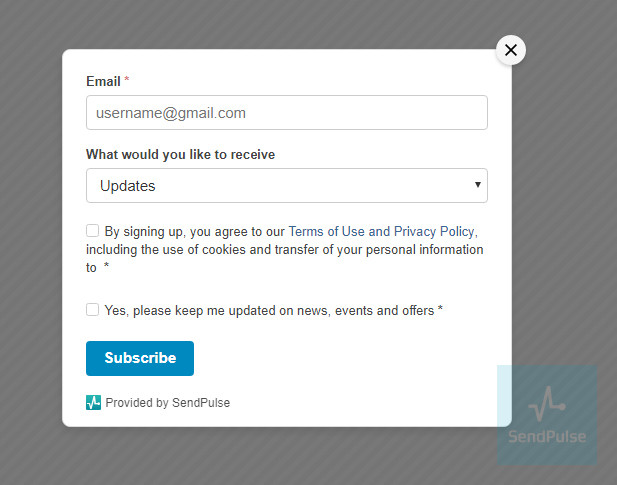 An example of a drop-down form created with SendPulse
An example of a drop-down form created with SendPulse
Experiment with adding different types of subscription forms every two weeks to find out which type converts better.
Just remember the latest GDPR rules: companies have to obtain explicit consent from a new subscriber to send them emails, plus they should make the unsubscribe process as easy as possible.
Double opt-in subscription would be a more reasonable choice in this regard: companies send users a confirmation email after they subscribe to the mailing list. This way, subscribers agree to provide their personal information for further processing and storage.
For example, California Walnuts send a confirmation email to their new subscribers to make sure the user is aware of the subscription. The CTA informs what is going to happen after the users click the button — they will join the company’s mailing list.
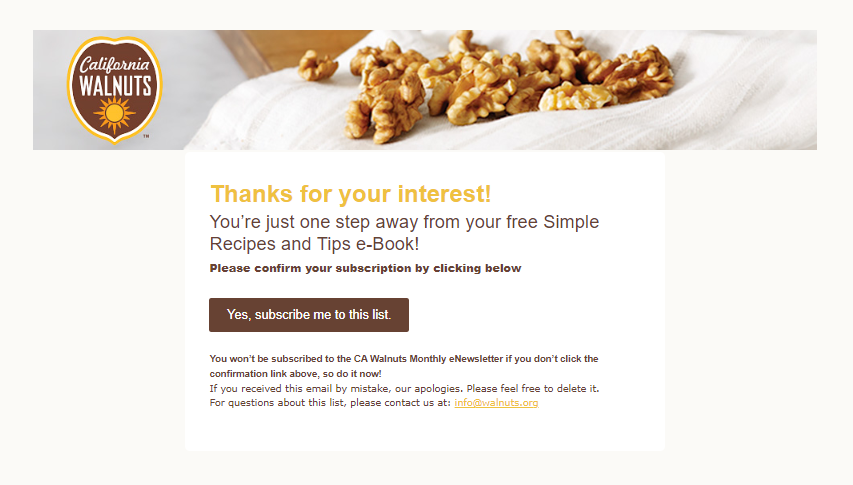 A confirmation email from California Walnuts
A confirmation email from California Walnuts
3. Segment your audience to send relevant content
Once you’ve figured out the goals of your email campaign and gathered the database, your next step should be segmenting your audience. According to the statistics, it’s the third most effective tactics used in email marketing after personalization and a smart CTA:
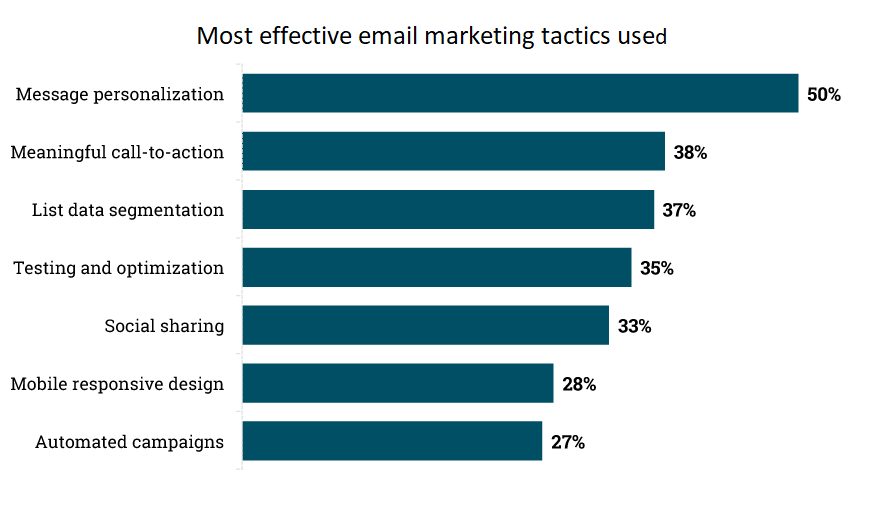 Source: Marketing Charts
Source: Marketing Charts
Segment your audience based on several variables:
- Demographics. Find out your subscribers’ age, gender, or occupation to come up with relevant offers in future.
- Location. Tailor your content to the place the subscribers live, so that subscribers from different countries can receive your emails at the corresponding time.
- Purchase history. Thank the subscribers for the purchase, remind to replenish their account or refresh the product they bought earlier, and encourage them to come back for another purchase.
- User’s activity. Active buyers, subscribers, dormant users are three different segments of your audience, so come up with personal addressing, different CTAs and special offers to reach each segment. Track users’ clicks and opens or their browsing history to offer the products or services which they would appreciate.
- Interests and preferences. Determine the desired content and frequency of your email campaign.
- Lifecycle stage. Send emails corresponding to the stage of the customer’s journey: a welcome email for new subscribers, an abandoned cart email for those who didn’t complete their order, or an email with a lead magnet to encourage a dormant user to take action.
Banana Republic, for instance, send a preference center link in one of their welcome emails to segment their audience according to the data provided.
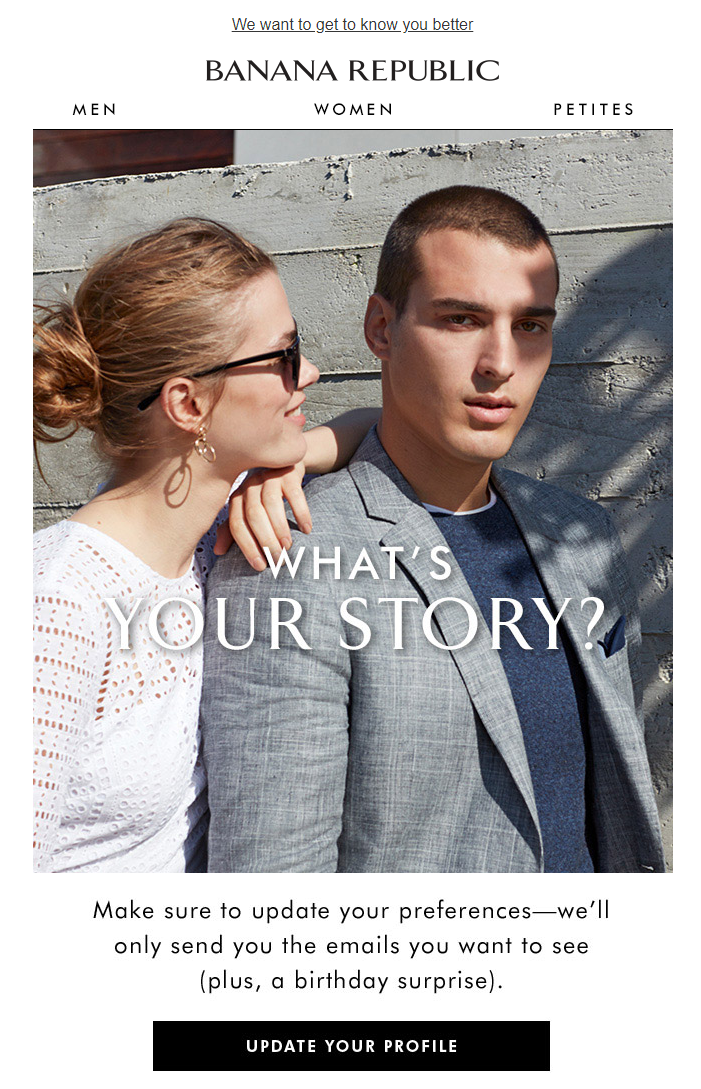 A welcome email with a link to preferences from Banana Republic
A welcome email with a link to preferences from Banana Republic
4. Create personalized subject lines
Apart from sending relevant content, database segmentation allows you to create personalized content for your audience. The use of personalization escalates the open rates as users are more likely to open the email that talks directly to them.
The first thing the user sees while checking the incoming emails is your subject line. If you want to catch people’s attention and not leave them indifferent, increase the value of your email in the subscriber’s inbox with subject lines based on recipients’ details. Apply any available information about a user: their name, age, gender, location, occupation, birthday or purchase history.
 A subject line personalized to the occupation in the email from LOFT
A subject line personalized to the occupation in the email from LOFT
Another personalization option is items left in the cart, browsed products or services. Track what the user has been up to lately and motivate them to complete the purchase.
 A subject line personalized to the browsed content in the email from TourRadar
A subject line personalized to the browsed content in the email from TourRadar
Personalization isn’t just about mentioning the user’s name; it is also about offering relevant perks based, for example, on the season or time of the day.
 A subject line personalized to the location in the email from Poncho
A subject line personalized to the location in the email from Poncho
5. Make mobile a top priority in your email strategy
Optimize your emails for mobile according to the following steps:
- Implement mobile-friendly sign-up forms to make the subscription process for mobile users as easy as possible.
- Shorten the subject line and knit it with the preheader text to clear up the content of your email for your subscribers while they’re just previewing your email.
- Keep your CTA button big and clear enough to make it comfortable to click on.
- Use responsive email templates to adjust your email for desktop and mobile devices.
Consider the example from Touch of Modern. The company organized their offers into a multicolumn view and here’s how the desktop version of their email looks:
 Desktop view of the multicolumn email from Touch of Modern
Desktop view of the multicolumn email from Touch of Modern
The same email transforms into a single-column product grid for those recipients who open it on mobile:
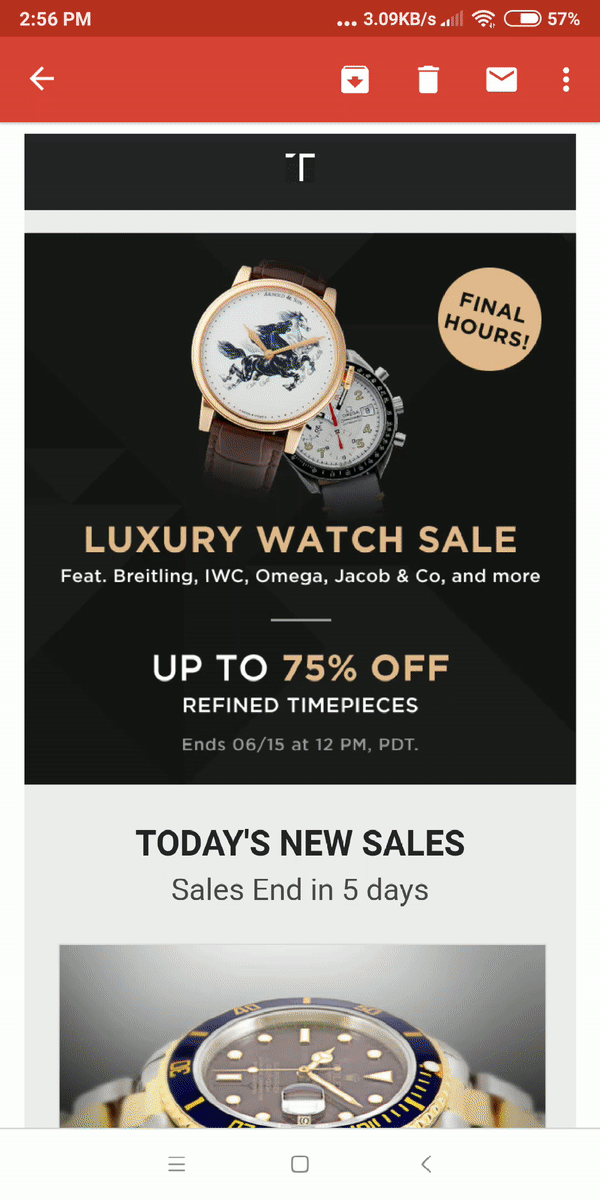 Mobile view of the multicolumn email from Touch of Modern
Mobile view of the multicolumn email from Touch of Modern
6. Use automation to reinforce your email campaign strategy
The wider your audience is, the trickier it becomes to create a relevant email campaign. Sending a bulk of emails to the whole mailing list or making individual emails is already a quaint anachronism. Today marketers automate their workflow to reach the users with relevant emails at the right time.
Email automation allows sending one-to-one emails driven by a specific trigger, such as signing up on the website, abandoning a cart, completing the purchase, celebrating a birthday, or joining the mailing list.
Hat tip to Adestra for their research, which outlined the foremost benefits marketers recognize after they automate their campaigns:
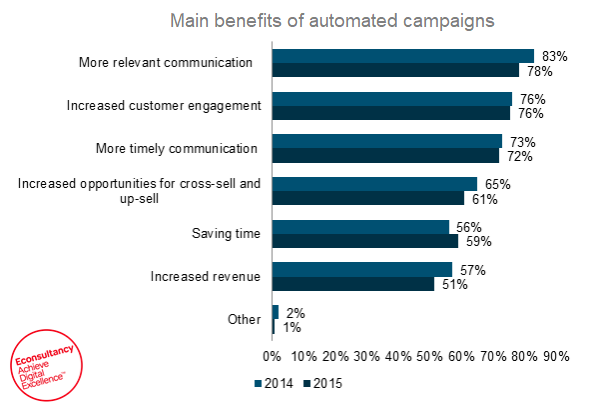 Source: Econsultancy
Source: Econsultancy
Triggered emails are based on subscriber’s behavior and typically include
Create automated emails in three steps using SendPulse Automation 360:
- Segment your audience and personalize your messages based on the results of segmentation.
- Create the automation flow in the corresponding menu of the sidebar and fill in all necessary data.
- Specify the filters to personalize the workflow, conditions to identify the next step of your automation campaign, actions to manage the mailing lists, goals to track the conversions and, eventually, building your automation. There you go!
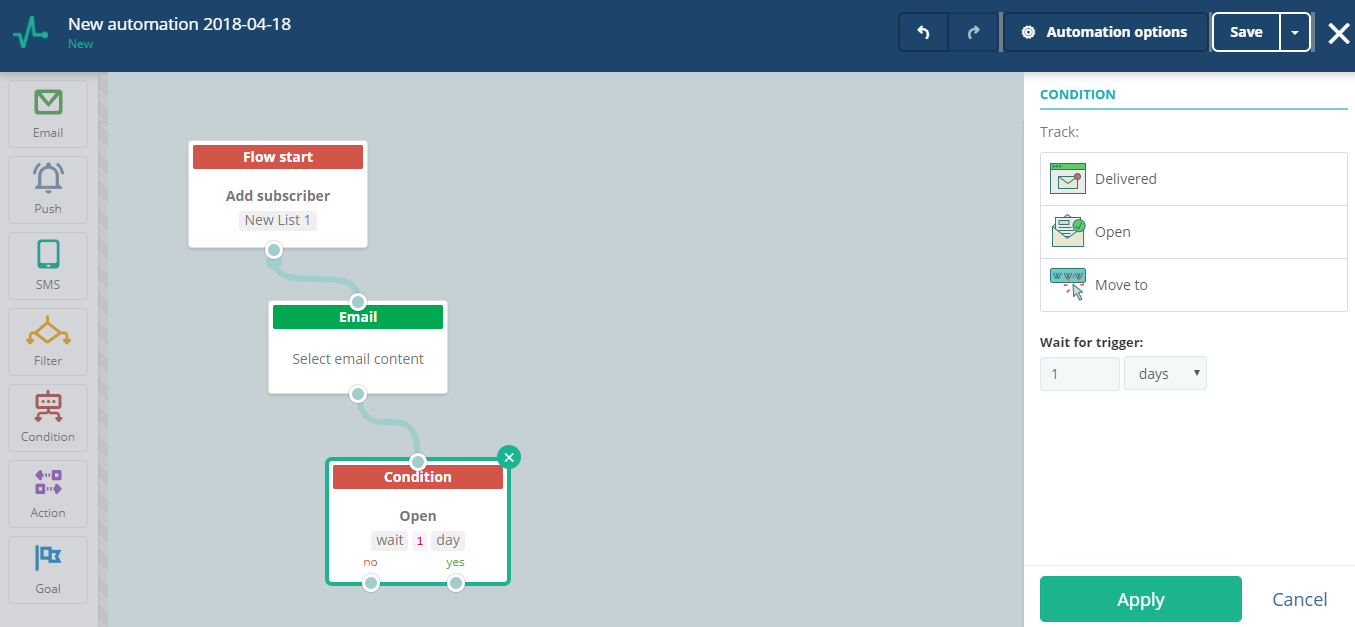 An example of a triggered email flow created with Automation 360
An example of a triggered email flow created with Automation 360
Yet automating your emails isn’t the only option to make up a good email marketing strategy. A/B testing makes it even better. Frequently called split testing, it is a way to compare two variations of the same email pursuing the same goal and identify which version performs better. Here’s how it works:
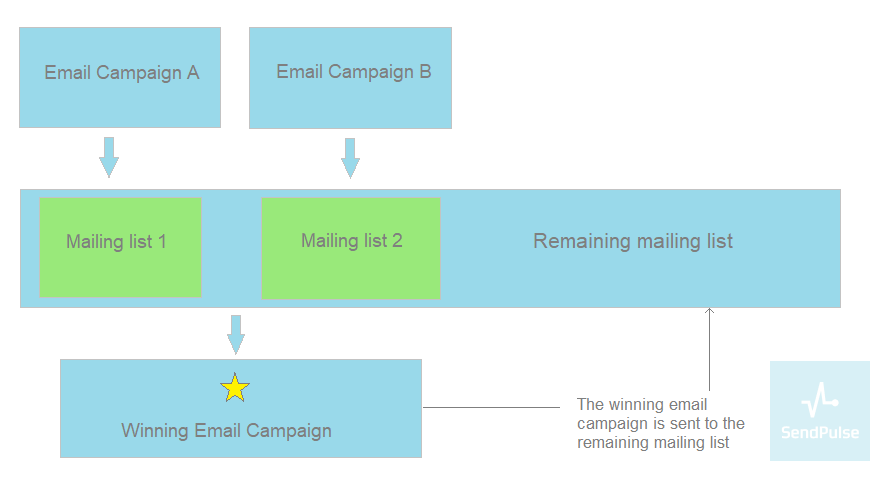 A/B testing basics
A/B testing basics
This kind of testing allows you to compare almost any element of your email: subject lines, sender name, links, position, color and copy of the CTAs, and the very content of the emails. You can also A/B test outside your inbox to check, for instance, whether or not the automation made of a single welcome email outperforms a series of such.
Final thoughts
Developing an effective email marketing strategy is a backbone of any business which presupposes six core steps:
- Define your goals to shape the audience, the content and tactics for your emails.
- Build a quality database using signup forms and use a double opt-in to get the list of subscribers who will be interested in your content.
- Segment your audience to send the users only relevant emails.
- Create personalized subject lines to engage your readers in your campaigns.
- Optimize your emails for mobile view to upgrade mobile users’ experience of interacting with your brand.
- Automate the workflow to provide your audience with appropriate content.
With all gathered tips in hand, you’re halfway to an effective email marketing strategy. SendPulse will do its best to help you with the second half. Good luck!